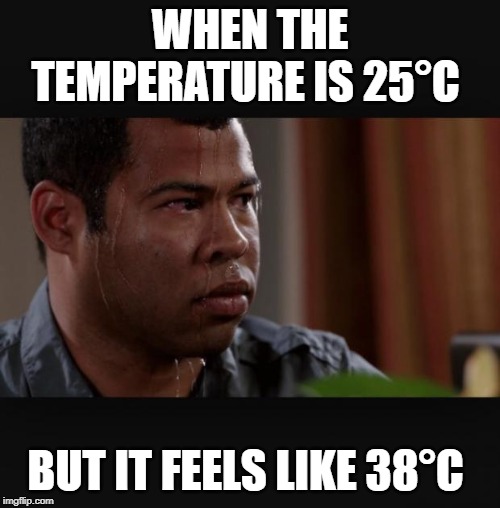Feels like temperature takes into account factors such as wind and humidity to find out how the weather would feel if one actually steps out.
Have you ever looked at the weather forecast and decided that it’s a perfect day for a picnic, but after stepping outside, you felt much warmer or colder than what the weatherman predicted? If you have, don’t worry… you’re not alone and the meteorology community isn’t involved in some vast conspiracy. It’s simply that the predicted temperature is not always what the real world feels like.
You have likely heard the term “feels like temperature” before. Most weather channels and meteorology apps have started using this term along with their usual verbiage to give people a better understanding of how they will actually feel out in their environment. So, what is this “feels like temperature”, and why is it different than the actual weather conditions?
What Is Temperature And How Do We Measure It?
To better understand this slightly nuanced topic, we must first understand the more fundamental concept of temperature. Basically, temperature is the measure of hotness and coldness. It is the degree of heat present in a substance that gives us the sensation of warmth. On a molecular level, temperature is the average kinetic energy possessed by the atoms of a material. The higher the temperature of an object, the higher is its kinetic energy. There are many units attributed to the measurement of temperature, but the most famous are Celsius, Fahrenheit and Kelvin.

Temperature is measured by instruments called thermometers. There is a wide variety of thermometers available on the market today, such as gas-bulb, mercury and bi-metal thermometers. Among these, the mercury in glass thermometer, also known as a maximum thermometer, is the simplest and most widely used. It is based on the basic principle that liquids expand when heated and contract when cooled. Thus, when the temperature increases, the mercury expands and rises up in the tube, and when the temperature decreases, it contracts and does the opposite. These movements are compared to a reference point to get the value of the temperature readings.
Also Read: Which Is Better – Celsius Or Fahrenheit?
What Is A Stevenson Screen?
A Stevenson Screen is a standard shelter that protects metrological instruments (thermometers, in particular) from rain, ultraviolet radiation and other environmental factors. It is a simple wooden box about 2 meters in height that is painted white to reflect the direct sunlight falling on it. To measure the exact temperature of a substance or an atmospheric region, it is necessary to eliminate the external factors that might affect the readings. This is why Stevenson screens provide the most accurate estimates of temperature.

What Is “Feels Like Temperature”?
As we already saw, measuring temperature consists of recording the air temperature from a thermometer that has been kept inside a Stevenson screen or by using any other appropriate instrument. “Feels like temperature”, on the other hand, is a calculated figure that considers several different factors apart from the temperature of the surrounding air. It gives people a better understanding of how they would feel if they actually went out in an area where the temperature had been recorded by some meteorological instrument.
The other factors taken into account by the “feels like temperature” are the speed and strength of wind, the temperature of the air, relative humidity of the area and the rate of heat loss from a human body when covered in clothes. When we combine all these factors and the measured temperature of the surrounding area, the final result is the so-called “feels like temperature”. So, how do these factors change our perception of hotness and coldness?
Why Does Wind Make Us Feel Colder Than It Really Is?
Let’s consider fast-moving wind for a moment. Humans are warm-blooded animals, and as a result, our body maintains itself within a fixed range of temperature—37 degrees Celsius is the average temperature of a healthy human body. Now, this heat flowing inside our hands, legs and other body parts is also transferred to the skin, which in turns heats the air surrounding it. As the temperature difference between our body and the air is reduced, we feel warm and cozy. What wind does is push this warm layer of air away, leaving our skin exposed to the surrounding cooler air, which makes us feel colder.

Also Read: If Our Body Temperature Is 37 Degrees Celsius, Why Do We Feel Hot When It’s 37 Degrees Outside?
Why Does Humidity Raise The Temperature Around Us?
Humidity, another factor that changes our perception of temperature, operates in a completely opposite manner. On a warm and sunny day, our body uses a very special process for cooling down the temperature of our body—it sweats! Sweat (i.e., salt water with some minerals and ions) absorbs the heat from the surrounding air and evaporates off our skin, providing a cooling sensation. This process is known as evaporative cooling. However, evaporative cooling is greatly reduced if the air around us is humid, meaning that it is already carrying water. As a result, the warm air and sweat remain on our skin, making us feel even hotter than the surrounding temperatures.
For measuring the “feels like temperature”, meteorologists use something called the Heat Index. The heat index (HI) is an index that combines air temperature and dew point (relative humidity) to determine the human-perceived equivalent temperature. At 85 degrees Fahrenheit with 10% humidity, the temperature feels closer to 79 degrees, but at 90% humidity, it will feel closer to 100 degrees. These values are found using a complex formula, but thanks to the National Weather Service, you can find the “feels like temperature” using this simple calculator- Heat Index Calculator. So, the next time someone asks you what the temperature is, don’t forget to mention what it “feels like” too!
Also Read: Does “100% Humidity” Basically Mean That Air Has Become Water?
Test how well you understand “feels like” temperature

